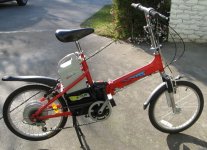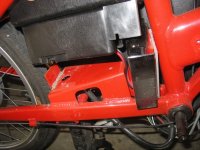Ok, I pulled the bike apart yesterday.
The wheels are NOT 20"... they're like 18" or something unusual like that. The other weird thing was that the cranks are shorter than normal, but only by about an inch, and the bolt holding them in place is not a left handed thread like on other bikes I've worked with.
The tires are made my Maxxis and labeled "for electric bicycle use only." I thought that was cute.
The rear triangle is extended to hold the battery and controller. The controller is small and in a box labeled E-Ton. It has a strip of 6 terminals on one side. All the chips on the PCB have the lettering on top scratched out and sharpied. The 6 FETs and UVW lettering on the terminal strips means the motor is 3 phase. It has hall sensors too. Many of the components are rated at 25v, so I don't see a 36v upgrade in the future.
The left hand grip has a twist for the derailleur, and the right grip is a throttle. There is a red cutoff switch below the throttle which turns the motor controller off. The brakes have switches that go back to the controller.
The controller won't let the motor spin unless 5mph or so has been reached. Then it's possible to stop pedaling. I could pedal faster than the motor could push me.
The battery box contains two SLA PE12v12 wired in series. The wires go to a fuse and then to a key lock. Not quite sure what happens in that area as I didn't trace it, but a the bottom of the box there are 3 wires, red blue and black that have an anderson connector. This connects to another anderson connector that is wired up to another connector that connects the batteries to their base when the box is dropped into its receptacle.
My set of lithiums would fit inside the battery box, but they're not doing well. This bike really needs a rear suspension, and the frame is very heavy. I may find another frame and transfer all the pieces to it. Additionally, this controller is pretty annoying. Someone asked about using a Kollmorgen controller on a hub motor, and though the Kollmorgen controller kind of sucks, you can probably see how it is better than the E-Ton controller.






